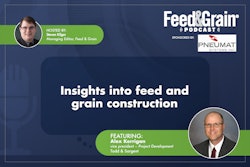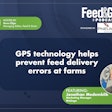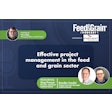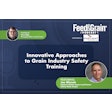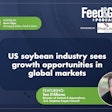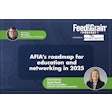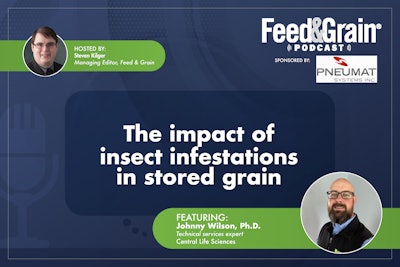
In this episode of the Feed & Grain Podcast, host Steven Kilger, managing editor of Feed & Grain Magazine, engages with Johnny Wilson, Ph.D., a technical services expert from Central Life Sciences. They explore the often-overlooked challenges of insect infestation in grain storage, discussing its growth, spread and impact on both quality and bottom line.
Wilson, with his rich background in grain processing and storage, brings to light the importance of proactive insect control measures over reactive ones. He emphasizes how active mitigation not only preserves grain quality but also ensures financial viability for storage facilities. The conversation takes place against the lively backdrop of this year's GEAPS Exchange, adding a dynamic and authentic feel to this informative session.
Listeners will gain valuable insights into best practices for insect control, the dangers of infestation, and the financial implications of pest management in grain storage. This episode is a must-listen for professionals in feed manufacturing, grain handling, and allied industries seeking to enhance their knowledge and practices in grain quality management.
Podcast sponsored by Pneumat Systems.
Steven Kilger (00;00):
Hi, everyone. My name is Steven Kilger, I'm the managing editor of Feed & Grain Magazine and the host of the Feed & Grain Podcast. Thank you so much for joining me today. As we dive deep into the issues affecting feed manufacturing, grain handling and allied industries. Today's episode is brought to you by the BinWhip from Pneumat Systems, the powerful Dual Impact BinWhip removes the toughest build-up and blockages in industrial storage silos — without hazardous silo entry. Learn more today at BinWhip.com.
Kilger (00;25):
Today's episode was recorded at this year's GEAPS Exchange with Johnny Wilson, Ph.D. to the technical services team at Central Life Sciences. We recorded at the show, which was fun, but means there's a little more background noise than normal. So please bear with us. We're talking about insect control in stored grain, how they grow and spread, different stages of infestation, why active mitigation is better than rescue operations and why it's important to the bottom line at your facility.
Kilger (00;56):
I hope you enjoy the interview. If you want to help out the podcast and are listening to this in a podcasting app, please rate and subscribe. If you're listening to this online, sign up for the Feed & Grain Newsletter Industry Watch to see the latest podcasts and stay up to date on all the latest news from around the industry.
Kilger (01;13):
Now with that out of the way onto the show.
Kilger (01;14):
So why don't we just start with you telling me and the listeners a little bit about yourself and what you do in the industry, kind of your background?
Johnny Wilson (01;25):
Yeah, absolutely. My name is Johnny Wilson. I do the technical service work for Central Life Science and the Specialty AG Department. So I handle all of the stored grain products. So I'm on the feed side.
Wilson (01;32):
My background is in feed manufacturing, grain processing, and grain storage. I'm a farm kid who grew up in central Kansas and I've kind of spent my whole life in agriculture. I love every minute of it. So whenever I get the chance to talk about feed and grain and grain processing and grain storage, I'm excited.
Kilger (01;55):
You're in the perfect place, right? You're on the podcast. So what we talk about right to everyone listening, we're actually at the GEAPS Exchange right now. Central Life Science has a booth. Can you talk a little bit more about the kind of the dangers of insect infestations and bulk grain storage and what effects that will have, especially towards the bottom line if you're not managing proactively managing that kind of thing?
Wilson (02;21):
Yeah. So absolutely, I'll start that off by telling a little bit of a story first that about a year and a half ago, Central Life Sciences decided that we needed to have a more robust technical service department devoted to answering some of these specific questions. Because of that, I joined the team and I am the only non-entomologist on the team.
Wilson (02;42):
I am a grain processor by trade and I know enough entomology to be dangerous and I lean on the rest of my group to help support that. And we've both learned a lot and taught each other a lot through the process. But really where our focus was was taking the financial metrics, putting insect damage in that context to our customers.
Wilson (03;06):
Historically, entomologists in our industry have done a great job from the qualitative aspects of insect infestation as it relates to whether you don't want bugs in your food. Everybody can agree on that story. That's an easy one. From an entomology perspective, it should be a relatively easy jump to say if you don't want it in your food, you don't want it in your raw ingredients.
Wilson (03;28):
So you're going to do everything that you can. Well, in a perfect world, that would be the case. But we have things called the cost analysis that we have to work through, and we have to financially prove to our own company that the things that we're doing make financial sense because, at the end of the day, you have to make money to keep the lights turned on.
Wilson (03;46):
So you can't just spend all you've got on everything. We would love to do that to completely eradicate pests, but you can do it. So bringing those financial metrics and tying pest control and IPM to that is credit. Being able to go into those meetings with the grain merchandisers procurement folks, nutritionists the folks that don't necessarily have the hands-on milling experience and being able to demonstrate to them these are how insects are causing you loss in profits due to a loss in raw ingredient, due to a loss in milling efficiency and just being able to tell that return on investment story to put their mind at ease.
Wilson (04;29):
Yeah, I know that we're adding $0.08 per bushel onto the cost and that's a scary proposition whenever you add anything to your cost of goods produced. But then being able to show the downstream benefits of your increasing milling yield, you're increasing net energy availability, metabolism of energy availability, just dry matter of quantity overall. And putting some metrics into that helps put their mind at ease and tell the story.
Kilger (04;57):
Yeah, yeah, that makes a lot of sense, especially because, well, I mean, it's about grain quality too, right? The worse grain quality is the more money it's going to cost to make your product and the more frankly dangerous it is to have that in storage. Right. Like insects create hot spots and hot spots lead to real issues with fires.
Wilson (05;18):
They absolutely do. In addition to that purely economic standpoint, where insects might cause a percentage of grain loss, you also have those or call them biological and physical risks associated with it. When insects feed, a lot of them create fines and those fines are expressed in grain dust as you work throughout the processing stages. It also can create brittle kernels, which through the milling process can also generate more dust and more fines.
Wilson (05;49):
Depending on the insect, you might have more moisture introduced or less moisture introduced, which then makes those hot spots and can increase, you know, been fires that way, or it can create more dust and create hazards that way. So also paring that environmental health and safety aspect with that, along with the financial now it starts to make sense when we can show value on multiple different stages.
Kilger (06;15):
So for companies that don't do this all the time and maybe are kind of more lax with their fumigation practices, you know, maybe they wait till there's an infestation and they throw some phosphine in there, and they kind of deal with it that way. What are some of the best practices and tips you have? Start their program and get it working in the right direction.
Wilson (06;35):
Yeah. So we need to think about these products in different classes and classify our customers into different buckets. So I'll go ahead and touch on that a little bit. In terms of the customers, we need to think about the on-farm production to also store quite a bit of inventory as well as the elevator side and then continue to the processing side.
Wilson (07;00):
And there's certainly value in all of those different levels that can be shown through using products like this and doing this preventative approach to IPM. Next, we need to get into the different classifications of products and again, put those in the buckets and have the preventative, reactionary, and all-encompassing product. So on the preventative side, you've got the insect growth regulators that are stopping that population growth by controlling the adolescents from reaching maturity and becoming reproductive adults.
Wilson (07;31):
Then you have the reactionary that is just taking out the adult populations, but you're not getting full coverage on those emerging adolescents that will become adults and will continue that problem. Then we have these all-encompassing products that handle all of the different life cycles and provide that complete control.
Kilger (07;55):
Yeah, yeah. And I mean, it seems to me like a no-brainer, right? As an outside observer in the industry, like, obviously you want to control all of it, right? You'd want to do it because once I use insects a lot is like an examples of exponential growth, right? It only takes a few days from you having a problem you can't even see to having a really bad infestation that you have to worry about.
Kilger (08;16):
Now. It can cost you a lot of money. How do you how should people kind of learn what kind of insects are in their grain, what kind of testing sampling should they do and what steps should they start putting these products on?
Wilson (08;25):
Yes, I will steal your segment there as a segue into talking about some of the research that we've done within the technical service group here at Central Life Sciences, about a year and a half ago, we decided to make a large investment in this space because we need to quantify the metrics that our customers use to make these decisions.
Wilson (08;48):
At the end of the day, we're in this business to make money and we have to demonstrate that the return that they're getting an appropriate return on their investment. You're committing a portion of your profits over to protecting the grain, protecting your investment. And we want to demonstrate that you're getting the most bang for your buck by the end of it.
Wilson (09;07):
And part of that is just showing and quantifying how much loss can result as a function of this insect infestation. So we've set up a series of trials where we look at different species of insects because that has a great impact on how much grain loss gets demonstrated in our trials. We looked at less rain borers and rice weevils and mapped out how much damage they can do over 30 days 60 days, and 90 days, quantifying all of the different parts of the hole that they are consuming from and then from that building and oral way to show the customers.
Wilson (09;46):
Well, I recognize that you've spent this much money, but you stand to gain this much when it comes to total grain loss and total fines reduction, and then we can carry that out into some other qualitative factors generating less dust due to the lack of feeding, you're helping to control that moisture migration that might be caused by insects. You get another level of biological control and pathogen control because we know that insects have an impact on the propagation of molds and the movement of salmonella through grain and things like that, which might be a little bit tougher by themselves to build a value story.
Wilson (10;26):
But when you combine it with that total grain loss now it becomes a no-brainer. We picked those dates because a big part of the feedback that we get is while I don't hold grain long enough, that's one of the cornerstone arguments against why I don't need to do IPM. I just don't hold grain long enough and they don't have enough time to do damage or even after 30 days in the right insect populations.
Wilson (10;51):
And if you have a big enough problem, which oftentimes the people that say, I don't need pest control because I don't hold it long enough, they're the ones with the biggest problem. Even after 30 days, we're demonstrating a positive ROI on handling those adult populations. If you get into a problematic situation, you might need that all-encompassing product that handles the adolescents, and the adults that have a center.
Wilson (11;15):
In addition to that, you might also have to do traditional fumigation and incorporate just general housekeeping keeping, then clean outs, perimeter sprays, doing all of that. Then once you get the population under control, you might be able to look back and say, Well, now we can just do adolescent control or now we can do a more robust rejection.
Wilson (11;39):
Even then, the market's changed and you might be in a year where you just can't afford to reject products and you're going to have to take that grain because you still got to run and we need to be cognizant of that. So are you willing to accept the risk of taking in those bad shipments and introducing bugs into a facility that's not protected now you're infesting everything on site and now you have to go back to square one.
Wilson (12;05):
Worked so much harder to get it back in line, which is so much easier and cost-effective to do that preventative step right from the beginning. But that can be difficult to do because oftentimes you don't see the bugs until there is a big problem already in there. So doing this financial analysis and demonstrating that we see shrink up above dry matter shrink, I'm talking about the actual grains being consumed that shrink not a moisture loss shrink above three and a half percent at 90 days with just less grain works with rice weevils, it's even higher.
Wilson (12;40):
That right there demonstrates an intense need for robust insect identification when it's coming in. Teaching your receiving guys the difference between a weevil and a red flower beetle or a lesser grain, or knowing what to look for and just demonstrating that destructive capability of the weevil and how deadly they are to operations. Well, yeah, well, that's the saying, right?
Kilger (13;04):
An ounce of prevention is worth a pound of cure. Once again, in my mind, it's a no-brainer. I just because even if you have such a turnover where you're getting rid of it in 30 days, all you're doing is passing on that infestation to someone else. Right. You might not have it be such a problem.
Wilson (13;20):
You have to deal with it. But if you're shipping grain then your customer might have to deal with it or you get a barge rejected or you get a ship rejected from another country. And then the kind of good luck explaining that. Well, you know, and we already do this analysis with recalls as part of your food safety plan.
Wilson (13;40):
We have a cost analysis set up for how much a recall costs. Well, that's why we have things like magnets in place. That's why we have all of these different preventative steps in place. We need to put this in the same mindset as that, that we are preventing that risk of future exposure that we are not financially prepared for, and that can cause a massive disruption to our operation, while also at the same time knowing what the cost benefits are immediately to us.
Wilson (14;12):
We will compare those things together. It becomes a no-brainer.
Kilger (14;24):
Yeah, definitely. So you are at Jeeps and you guys essentially science have just kind of launched a new product called Gravista®-D. Can you explain a little bit about it and where it fits in that chain of prevention? You put it so elegantly I can't.
Wilson (14;30):
So I came up with those buckets because I got so sick and tired of hearing this idea of a rescue treatment. And the example I like to use is when you see the bugs. Now you want to do a rescue treatment on the ground. And my argument is you're not rescuing at that point because there's already been damage done. We can blend away the shrink. Yeah, you can blend the grain down to get it to an acceptable 80, an acceptable level of insect damage kernel.
Wilson (15;00):
Or you can get it blended down. So there are not as many live insects, but there's still been a quantity of grain that has been consumed and it's lost. You can't blend away that strength, period. So is it a rescue now? It's a response. Someone's drowning out in the ocean. You toss them a life preserver and then drive away.
Wilson (15;17):
Yeah. So at least they're not drowning anymore, but they're still in trouble. Now we need to go back and do that all-encompassing package. We need to control the adults, and the adolescents, and then help boost its effectiveness. That's where Gravista®-D comes into play. It has three different active ingredients and has that insect growth regulator of the air in the form of asthma that's stopping those populations from getting out of control, stopping that growth cycle and the adolescents from reaching the mature age.
Wilson (15;48):
But it's also handling the adults as it comes in. The PBO aid is added in as a synergistic to not only boost the effectiveness and prevent future resistance from happening but also increase the rates of absorption because all of these active ingredients, need to come into contact with the insect or they need to be consumed by the insects to be effective.
Wilson (16;10):
So also noting that we need to have a good operation to apply this, this product is pretty key. One place where fumigation is nice is you can do it inside of bin without actually moving grain. Arce needs to be applied onto the grain stream as it's moving in. We have some very easy ways of doing that on receiving legs as it's coming in on drag conveyors underneath puppets and underneath the receiving base.
Wilson (16;39):
Some operations just depend on what their labor force might look like or how far north they are, how often they freeze, or any other number of quality-of-life things. Sometimes it just makes more sense to use a tri product and certainly, if you have a smaller operation that maybe you only hold 50,000 bushels worth of grain, you don't want to set up a liquid system that maybe you only utilized for a week out of the year and then have to do maintenance on it makes a lot more sense to use a dry product and have that be applied and you can do that manually.
Wilson (17;13):
Certainly, there's also some very, very low-cost, appropriately priced machinery that can do it on the inline grain stream. I'm talking less than $1,000 to do something like this and then you're completely hands-off. You're not committing the labor to doing anything like this. And it's just all about convenience. It's putting it in the package that's easiest to utilize for the customer and removing those barriers to use.
Kilger (17;37):
Yeah, and well, that's where it once again, going back to like a safety thing, like the only doing it once in a while. When you do have that risk that's where mistakes happen, right? That is where someone makes a mistake. Someone doesn't fill out the paperwork correctly. If someone doesn't get the right permits in place like they don't do the right steps and that So having it just as part of your process just makes sense to me because let's face it, your grain has insects in it.
Kilger (18;03):
It just does. There is no there's no truckload of grain out there that doesn't have any eggs or insects in it. It just gives me enough time and I'll find one exactly. So it just makes sense to be like, just to continue as part of my process. But for people who want to learn more, where should they go to find out more information?
Wilson (18;24):
Yeah, we have a great Web site called bugfreegrains.com. When you go to that first loading page, it gives you all the information that you want about all of the products that we have to offer, how they can be implemented in your process, and some of the machinery options that you have to do the application.
Wilson (18;41):
It's nice because you don't need any sort of fumigation certification to use it. Any Joe off the street can just buy this stuff and use it. It's incredibly safe and easy to use all of these products in dry and liquid form just for that convenience factor. And that's the thing. We want to remove those barriers to entry. It doesn't need to be scary.
Wilson (19;00):
It needs to be easy and it needs to be cost-effective to do it. So from that page, there are also some informative videos that that I've been doing and some of the other folks within our organization to just help educate customers on the different values that can be shown by using our products and how easy it is.
Wilson (19;19):
In addition to that, we have a mailing list that you can get on some you blast and stay in the know on some of the new and upcoming things that we have in the pipeline. Yeah, the pleasure marketing team does a great job of making things fun and interesting and I mean I know that sounds like it shouldn't be a big deal, but as anyone who's tried to go through research papers to figure out how this stuff works, you can kind of get in the weeds real, real fast and go over at least my head behind it.
Wilson (19;47):
And I think I'm allowed to say this since I've got some letters after my name. But we as researchers do a very poor job of conveying all of this great research and great things to the general public. And if we have a failing, it's that. So pairing that with an effective marketing strategy. Yeah, just because you've gathered all of this amazing research and done this, you know, life-changing thing, if no one reason it doesn't matter.
Kilger (20;10):
Exactly. Exactly. Well, thank you so much for talking to me, Johnny. It's been a pleasure. Absolutely. Thanks for having me. And thank you, everyone out there for listening. Until next time, stay safe.
.jpg?auto=format%2Ccompress&crop=faces&fit=crop&h=48&q=70&w=48)


